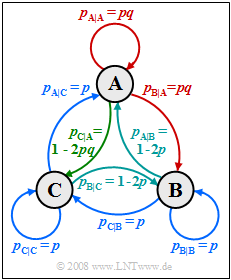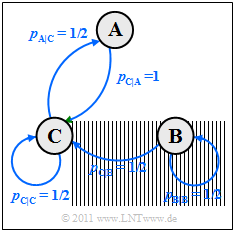Aufgaben:Aufgabe 1.6Z: Ternäre Markovquelle: Unterschied zwischen den Versionen
| Zeile 10: | Zeile 10: | ||
Aufgrund der Markoveigenschaft dieser Quelle kann die Entropie auf unterschiedliche Weise ermittelt werden: | Aufgrund der Markoveigenschaft dieser Quelle kann die Entropie auf unterschiedliche Weise ermittelt werden: | ||
| − | *Man berechnet die | + | *Man berechnet die beiden ersten Entropienäherungen $H_1$ und $H_2$. Dann gilt für die tatsächliche Entropie: |
:$$H = 2 \cdot H_{\rm 2} - H_{\rm 1} \hspace{0.05cm}.$$ | :$$H = 2 \cdot H_{\rm 2} - H_{\rm 1} \hspace{0.05cm}.$$ | ||
| − | *Nach der | + | *Nach der „direkten Berechnungsmethode” kann die Entropie aber auch wie folgt geschrieben werden (insgesamt neun Terme): |
:$$H = p_{\rm AA} \cdot {\rm log_2}\hspace{0.1cm}\frac {1}{ p_{\rm A\hspace{0.01cm}|\hspace{0.01cm}A}} + p_{\rm AB} \cdot {\rm log_2}\hspace{0.1cm}\frac {1}{ p_{\rm B\hspace{0.01cm}|\hspace{0.01cm}A}} + \ \text{...} | :$$H = p_{\rm AA} \cdot {\rm log_2}\hspace{0.1cm}\frac {1}{ p_{\rm A\hspace{0.01cm}|\hspace{0.01cm}A}} + p_{\rm AB} \cdot {\rm log_2}\hspace{0.1cm}\frac {1}{ p_{\rm B\hspace{0.01cm}|\hspace{0.01cm}A}} + \ \text{...} | ||
\hspace{0.05cm}, \ | \hspace{0.05cm}, \ | ||
Version vom 21. Juni 2021, 14:59 Uhr
Die Grafik zeigt eine Markovquelle mit $M = 3$ Zuständen $\rm A$, $\rm B$ und $\rm C$.
Für die beiden Parameter dieses Markovprozesses soll gelten:
- $$0 \le p \le 0.5 \hspace{0.05cm},\hspace{0.2cm}0 \le q \le 1 \hspace{0.05cm}.$$
Aufgrund der Markoveigenschaft dieser Quelle kann die Entropie auf unterschiedliche Weise ermittelt werden:
- Man berechnet die beiden ersten Entropienäherungen $H_1$ und $H_2$. Dann gilt für die tatsächliche Entropie:
- $$H = 2 \cdot H_{\rm 2} - H_{\rm 1} \hspace{0.05cm}.$$
- Nach der „direkten Berechnungsmethode” kann die Entropie aber auch wie folgt geschrieben werden (insgesamt neun Terme):
- $$H = p_{\rm AA} \cdot {\rm log_2}\hspace{0.1cm}\frac {1}{ p_{\rm A\hspace{0.01cm}|\hspace{0.01cm}A}} + p_{\rm AB} \cdot {\rm log_2}\hspace{0.1cm}\frac {1}{ p_{\rm B\hspace{0.01cm}|\hspace{0.01cm}A}} + \ \text{...} \hspace{0.05cm}, \ \text{wobei} \ p_{\rm AA} = p_{\rm A} \cdot p_{\rm A\hspace{0.01cm}|\hspace{0.01cm}A} \hspace{0.05cm},\hspace{0.2cm} p_{\rm AB} = p_{\rm A} \cdot p_{\rm B\hspace{0.01cm}|\hspace{0.01cm}A} \hspace{0.05cm}, \ \text{...}$$
Hinweise:
- Die Aufgabe gehört zum Kapitel Nachrichtenquellen mit Gedächtnis.
- Bezug genommen wird insbesondere auf die Seite Nichtbinäre Markovquellen.
- Bei allen Entropien ist die Pseudoeinheit „bit/Symbol” hinzuzufügen.
Fragebogen
Musterlösung
- $p_{\rm A} = p_{\rm A|A} = p_{\rm A|B} = p_{\rm A|C} = 1/3$,
- $p_{\rm B} = p_{\rm B|A} = p_{\rm B|B} = p_{\rm B|C} = 1/3$,
- $p_{\rm C} = p_{\rm C|A} = p_{\rm C|B} = p_{\rm C|C} = 1/3$.
Daraus lassen sich die gesuchten Werte bestimmen:
- Beispielsweise erhält man aus $p_{\rm C|C} = 1/3$ den Wert $p \hspace{0.15cm}\underline{= 1/3}$.
- Berücksichtigt man noch die Beziehung $p_{\rm A|A} = p \cdot q$, so folgt $q \hspace{0.15cm}\underline{= 1}$.
- Damit ergibt sich die maximale Entropie $H_\text{max} ={\rm log_2} \ 3\hspace{0.15cm}\underline{= 1.585\ \rm bit/Symbol}$.
(2) Mit den Parameterwerten $p = 1/4$ und $q = 1$ ergibt sich das nebenstehende Übergangsdiagramm, das folgende Symmetrien aufweist:
- $p_{\rm A|A} = p_{\rm B|B} = p_{\rm C|C} = 1/4$ (rot markiert),
- $p_{\rm A|B} = p_{\rm B|C} = p_{\rm C|A} = 1/2$ (grün markiert),
- $p_{\rm A|C} = p_{\rm B|A} = p_{\rm C|CB} = 1/4$ (blau markiert).
Es ist offensichtlich, dass die Symbolwahrscheinlichkeiten alle gleich sind:
- $$p_{\rm A} = p_{\rm B} = p_{\rm C} = 1/3 \hspace{0.3cm} \Rightarrow \hspace{0.3cm} H_1 = {\rm log_2}\hspace{0.1cm} 3 \hspace{0.15cm} \underline {= 1.585 \,{\rm bit/Symbol}} \hspace{0.05cm}.$$
(3) Für die zweite Entropienäherung benötigt man $3^2 = 9$ Verbundwahrscheinlichkeiten.
- Mit dem Ergebnis aus (2) erhält man hierfür:
- $$p_{\rm AA} = p_{\rm BB}= p_{\rm CC}= p_{\rm AC}=p_{\rm BA}=p_{\rm CB}=1/12 \hspace{0.05cm},\hspace{0.5cm} p_{\rm AB} = p_{\rm BC}=p_{\rm CA}=1/6$$
- $$\Rightarrow \hspace{0.2cm} H_2 = \frac{1}{2} \cdot \left [ 6 \cdot \frac{1}{12} \cdot {\rm ld}\hspace{0.1cm} 12 + 3 \cdot \frac{1}{6} \cdot {\rm log_2}\hspace{0.1cm} 6 \right ] = \frac{1}{4} \cdot {\rm log_2}\hspace{0.1cm} 4 + \frac{1}{4} \cdot {\rm log_2}\hspace{0.1cm} 3 + \frac{1}{4} \cdot {\rm log_2}\hspace{0.1cm} 2 + \frac{1}{4} \cdot {\rm log_2}\hspace{0.1cm} 3 = \frac{3}{4} + \frac{{\rm log_2}\hspace{0.1cm} 3}{2} \hspace{0.15cm} \underline {= 1.5425 \,{\rm bit/Symbol}} \hspace{0.05cm}.$$
(4) Aufgrund der Markoveigenschaft der Quelle gilt
- $$H = 2 \cdot H_2 - H_1 = \big [ {3}/{2} + {\rm log_2}\hspace{0.1cm} 3 \big ] - {\rm log_2}\hspace{0.1cm} 3\hspace{0.15cm} \underline {= 1.5 \,{\rm bit/Symbol}} \hspace{0.05cm}.$$
- Zum gleichen Ergebnis würde man nach folgender Rechnung kommen:
- $$H= p_{\rm AA} \cdot {\rm log_2}\hspace{0.1cm}\frac {1}{ p_{\rm A\hspace{0.01cm}|\hspace{0.01cm}A}} + p_{\rm AB} \cdot {\rm log_2}\hspace{0.1cm}\frac {1}{ p_{\rm B\hspace{0.01cm}|\hspace{0.01cm}A}} + ... \hspace{0.1cm}= 6 \cdot \frac{1}{12} \cdot {\rm log_2}\hspace{0.1cm} 4 + 3 \cdot \frac{1}{16} \cdot {\rm log_2}\hspace{0.1cm} 2 \hspace{0.15cm} \underline {= 1.5 \,{\rm bit/Symbol}} \hspace{0.05cm}.$$
(5) Aus dem nebenstehendenm Übergangsdiagramm mit den aktuellen Parametern erkennt man, dass bei Stationarität $p_{\rm B} = 0$ gelten wird, da $\rm B$ höchstens zum Startzeitpunkt einmal auftreten kann.
- Es liegt also eine binäre Markovkette mit den Symbolen $\rm A$ und $\rm C$ vor.
- Die Symbolwahrscheinlichkeiten ergeben sich demzufolge zu:
- $$p_{\rm A} = 0.5 \cdot p_{\rm C} \hspace{0.05cm}, \hspace{0.2cm}p_{\rm A} + p_{\rm C} = 1 \hspace{0.3cm} \Rightarrow \hspace{0.3cm} p_{\rm A} = 1/3 \hspace{0.05cm}, \hspace{0.2cm} p_{\rm C} = 2/3\hspace{0.05cm}. $$
- Damit erhält man folgende Wahrscheinlichkeiten:
- $$p_{\rm A\hspace{0.01cm}|\hspace{0.01cm}A} \hspace{0.1cm} = \hspace{0.1cm}0\hspace{0.7cm} \Rightarrow \hspace{0.3cm} p_{\rm AA} = 0 \hspace{0.05cm},$$
- $$ p_{\rm A\hspace{0.01cm}|\hspace{0.01cm}C} =1/2\hspace{0.3cm} \Rightarrow \hspace{0.3cm} p_{\rm CA} = p_{\rm C} \cdot p_{\rm A\hspace{0.01cm}|\hspace{0.01cm}C} = 2/3 \cdot 1/2 = 1/3 \hspace{0.05cm},\hspace{0.2cm}{\rm log_2}\hspace{0.1cm}(1/p_{\rm A\hspace{0.01cm}|\hspace{0.01cm}C} )= 1\hspace{0.05cm},$$
- $$ p_{\rm C\hspace{0.01cm}|\hspace{0.01cm}A} =1\hspace{0.7cm} \Rightarrow \hspace{0.3cm} p_{\rm AC} = p_{\rm A} \cdot p_{\rm C\hspace{0.01cm}|\hspace{0.01cm}A} = 1/3 \cdot 1 = 1/3 \hspace{0.05cm},\hspace{0.61cm}{\rm log_2}\hspace{0.1cm}(1/p_{\rm C\hspace{0.01cm}|\hspace{0.01cm}A} )= 0\hspace{0.05cm},$$
- $$ p_{\rm C\hspace{0.01cm}|\hspace{0.01cm}C} =1/2\hspace{0.3cm} \Rightarrow \hspace{0.3cm} p_{\rm CC} = p_{\rm C} \cdot p_{\rm C\hspace{0.01cm}|\hspace{0.01cm}C} = 2/3 \cdot 1/2 = 1/3\hspace{0.05cm},\hspace{0.2cm}{\rm log_2}\hspace{0.1cm}(1/p_{\rm C\hspace{0.01cm}|\hspace{0.01cm}C} )= 1 $$
- $$\Rightarrow \hspace{0.25cm} H = p_{\rm AA} \cdot {\rm log_2}\hspace{0.1cm}\frac {1}{ p_{\rm A\hspace{0.01cm}|\hspace{0.01cm}A}} +p_{\rm CA} \cdot {\rm log_2}\hspace{0.1cm}\frac {1}{ p_{\rm A\hspace{0.01cm}|\hspace{0.01cm}C}}+ p_{\rm AC} \cdot {\rm log_2}\hspace{0.1cm}\frac {1}{ p_{\rm C\hspace{0.01cm}|\hspace{0.01cm}A}} + p_{\rm CC} \cdot {\rm log_2}\hspace{0.1cm}\frac {1}{ p_{\rm C\hspace{0.01cm}|\hspace{0.01cm}C}}= 0 + 1/3 \cdot 1 + 1/3 \cdot 0 + 1/3 \cdot 1 \hspace{0.15cm} \underline {= 0.667 \,{\rm bit/Symbol}} \hspace{0.05cm}.$$

